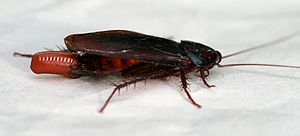Smokybrown cockroach
The smokybrown cockroach (Periplaneta fuliginosa) is a large species of cockroach, winged, and growing to a length of 1¼–1⅜ in.
| Smokybrown cockroach | |
|---|---|
 | |
| P. fuliginosa laying an egg case | |
| Scientific classification | |
| Kingdom: | |
| Phylum: | |
| Class: | |
| Order: | |
| Family: | |
| Genus: | |
| Species: | P. fuliginosa |
| Binomial name | |
| Periplaneta fuliginosa (Serville, 1839) | |
Characteristics
Although closely related to the American cockroach (Periplaneta americana), the smokybrown cockroach is readily distinguishable from it by its uniformly dark brown–mahogany coloration. Furthermore, unlike the American cockroach, which possess a light-rimmed pattern on its thorax, the smokybrown cockroach's thorax is dark and shiny.
Diet
The smokybrown cockroach is a detritivore and can feed off a wide array of organic (including decaying) matter. Like most cockroaches, it is a scavenger. It tends to lose more moisture than its relatives and requires water every 2–3 days.
Behaviour
The smokybrown cockroach may come indoors to look for food and even to live; generally, however, in warm weather, it will move outdoors.[1]
Habitat
The smokybrown cockroach is very common in Japan, as well as the southern United States and tropical climates; notably, it can be found in Florida, Eastern North Carolina, Louisiana, Mississippi, Texas, and other moist Gulf coastal states, and along the southern Mississippi River. The cockroach can also be found in Australia, such as in warmer cities like Sydney and Brisbane.
The smokybrown cockroach prefers warmer climates and is not cold-tolerant. It may, however, be able to survive colder climates by going indoors. In addition to this, it fares well in moist conditions and appears to be particularly prevalent in moist concealed areas. It often lives around the perimeter of buildings.
Additional images
 Young instar nymphs
Young instar nymphs
References
- Grimaldi D., Engel M.S. (2005.) Evolution of the Insects, Cambridge University Press, New York City, NY, USA.
| Wikispecies has information related to Periplaneta fuliginosa |
| Wikimedia Commons has media related to Periplaneta fuliginosa. |
External links
- Black and white photographs of top view of P. fuliginosa male and female specimens, from Smithsonian Miscellaneous Collections.
- Drawings of body parts of male P. fuliginosa; plate VII, figures 20-24 show detail of the pronotum, end of abdomen with cerci, supra-anal plate, subgenital plate, and genital process. From a 1917 article[1] by Morgan Hebard, with a key to the figures on page 281.
- Hebard, Morgan (1917). "The Blattidae of North America north of the Mexican boundary". Memoirs of the American Entomological Society. American Entomological Society (2). (The article comprises the whole issue.)